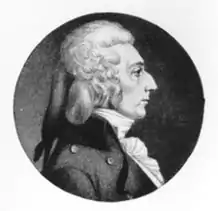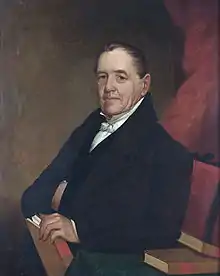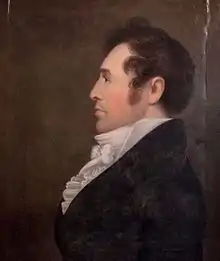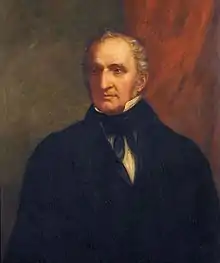Rhode Island's at-large congressional district
The Rhode Island at-large congressional district is currently obsolete, with representation divided into two districts. However, based on population estimates, reapportionment will likely cause Rhode Island to have only one congressional district after the 2020 census.[1]
From 1790 to 1843, Rhode Island elected members to the United States House of Representatives at-large:
- From 1790 to 1793, one member represented the state.
- From 1793 to 1843, two members represented the state at-large.
List of members representing the district
| Cong ress |
Years | Seat A | Seat B | |||||
|---|---|---|---|---|---|---|---|---|
| Representative | Party | Electoral history | Representative | Party | Electoral history | |||
| 1st | August 31, 1790 – March 3, 1791 |
 Benjamin Bourne |
Pro-Admin | Elected in August 1790. Re-elected in October 1790. Re-elected in 1792. Re-elected in 1794. Re-elected in 1796, but declined the seat and resigned. |
Seat created in 1793 | |||
| 2nd | March 3, 1791 – March 3, 1793 | |||||||
| 3rd | March 3, 1793 – March 3, 1795 |
Francis Malbone | Pro-Admin | Elected in 1792. Re-elected in 1794. Retired. | ||||
| 4th | March 4, 1795 – 1796 |
Federalist | Federalist | |||||
| 1796 – November 15, 1796 |
Vacant | |||||||
| November 15, 1796 – March 3, 1797 |
 Elisha Reynolds Potter |
Federalist | Elected to finish Bourne's term and to the next term. Resigned. | |||||
| 5th | March 4, 1797 – 1797 |
 Christopher G. Champlin |
Federalist | Elected in 1796. Re-elected in 1798. Lost re-election. | ||||
| 1797 – November 13, 1797 |
Vacant | |||||||
| November 13, 1797 – March 3, 1799 |
Thomas Tillinghast | Federalist | Elected to finish Potter's term. Lost re-election. | |||||
| 6th | March 4, 1799 – March 3, 1801 |
 John Brown |
Federalist | Elected in 1798. Lost re-election. | ||||
| 7th | March 4, 1801 – March 3, 1803 |
Joseph Stanton Jr. | Democratic-Republican | Elected in 1800. Re-elected in 1802. Re-elected in 1804. Retired. |
Thomas Tillinghast | Democratic-Republican | Elected in 1800. Lost re-election. | |
| 8th | March 4, 1803 – March 3, 1805 |
Nehemiah Knight | Democratic-Republican | Elected in 1802. Re-elected in 1804. Re-elected in 1806. Died. | ||||
| 9th | March 4, 1805 – March 3, 1807 | |||||||
| 10th | March 4, 1807 – March 3, 1808 |
_2.jpg.webp) Isaac Wilbour |
Democratic-Republican | Elected in 1806. Lost re-election. | ||||
| March 4, 1808 – June 13, 1808 | ||||||||
| June 13, 1808 – November 11, 1808 |
Vacant | |||||||
| November 11, 1808 – March 3, 1809 |
 Richard Jackson Jr. |
Federalist | Elected August 30, 1808 to finish Knight's term and seated November 11, 1808. Also elected the same day to the next term. Re-elected in 1810. Re-elected in 1812. Retired. | |||||
| 11th | March 4, 1809 – March 3, 1811 |
 Elisha Reynolds Potter |
Federalist | Elected in 1808. Re-elected in 1810. Re-elected in 1812. Retired. | ||||
| 12th | March 4, 1811 – March 3, 1813 | |||||||
| 13th | March 4, 1813 – March 3, 1815 | |||||||
| 14th | March 4, 1815 – March 3, 1817 |
John Linscom Boss Jr. | Federalist | Elected in 1814. Elected in 1816. Retired. |
 James Brown Mason |
Federalist | Elected in 1814. Elected in 1816. Retired. | |
| 15th | March 4, 1817 – March 3, 1819 | |||||||
| 16th | March 4, 1819 – December 17, 1820 |
Samuel Eddy | Democratic-Republican[lower-alpha 1] | Elected in 1818. Re-elected in 1820. Re-elected in 1822. Lost re-election. |
Nathaniel Hazard | Democratic-Republican | Elected in 1818. Lost re-election then died. | |
| December 17, 1820 – March 3, 1821 |
Vacant | |||||||
| 17th | March 4, 1821 – March 3, 1823 |
Job Durfee | Democratic-Republican[lower-alpha 1] | Elected in 1820. Re-elected in 1822. Lost re-election. | ||||
| 18th | March 4, 1823 – March 3, 1825 | |||||||
| 19th | March 4, 1825 – March 3, 1827 |
 Tristam Burges |
Anti-Jacksonian | Elected in 1825. Re-elected in 1827. Re-elected in 1829. Re-elected in 1831. Re-elected in 1833. Lost re-election. |
Dutee Jerauld Pearce | Anti-Jacksonian | Elected in 1825 on the second ballot. Re-elected in 1827. Re-elected in 1829. Re-elected in 1831. Re-elected in 1833. Re-elected in 1835. Lost re-election. | |
| 20th | March 4, 1827 – March 3, 1829 | |||||||
| 21st | March 4, 1829 – March 3, 1831 | |||||||
| 22nd | March 4, 1831 – March 3, 1833 | |||||||
| 23rd | March 4, 1833 – March 3, 1835 |
Anti-Masonic | ||||||
| 24th | March 4, 1835 – March 3, 1837 |
 William Sprague III |
Whig | Elected in 1835. Retired. | ||||
| 25th | March 4, 1837 – March 3, 1839 |
Robert B. Cranston | Whig | Elected in 1837. Re-elected in 1839. Re-elected in 1841. Retired. |
Joseph L. Tillinghast | Whig | Elected in 1837. Re-elected in 1839. Re-elected in 1841. Retired. | |
| 26th | March 4, 1839 – March 3, 1841 | |||||||
| 27th | March 4, 1841 – March 3, 1843 | |||||||
Notes
- Supported the Adams-Clay faction in the 1824 United States presidential election.
References
- Martis, Kenneth C. (1989). The Historical Atlas of Political Parties in the United States Congress. New York: Macmillan Publishing Company.
- Martis, Kenneth C. (1982). The Historical Atlas of United States Congressional Districts. New York: Macmillan Publishing Company.
- Congressional Biographical Directory of the United States 1774–present
This article is issued from Wikipedia. The text is licensed under Creative Commons - Attribution - Sharealike. Additional terms may apply for the media files.